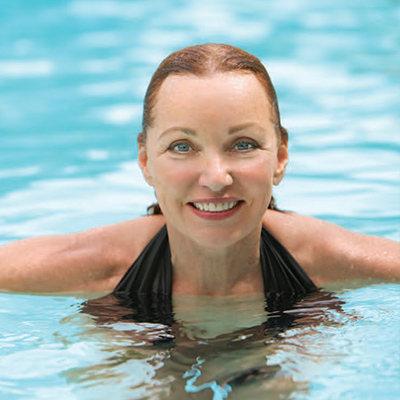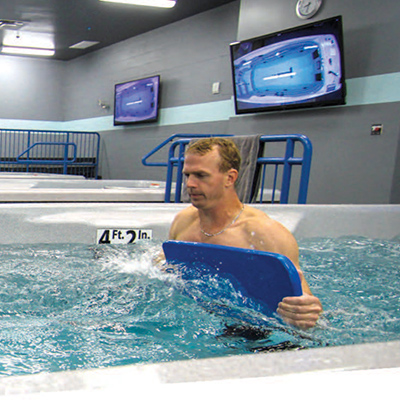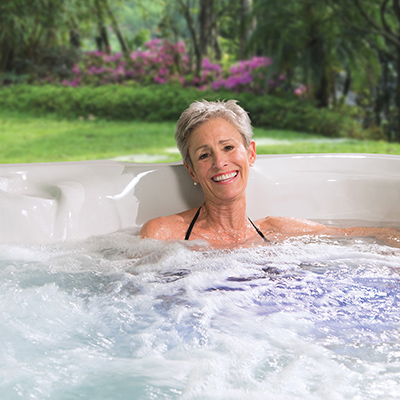
Pain Relieving Power of Aquatic Therapy
Could Aquatic Exercise Be Your Pain Relief Solution?
Millions of people suffer from chronic pain or chronic fatigue. If you're one of them, then aquatic exercise may be the answer to help better manage your symptoms and improve your overall quality of life.
Having a chronic pain condition such as fibromyalgia, myofascial pain syndrome or chronic fatigue syndrome can be very frustrating. People often become very inactive because it hurts too much to move which leads to tightness and weakness of the muscles as well as increased fatigue. People then develop poor postures from trying to avoid certain painful movements and this often leads to the development of what is termed a "Pain Cycle". If you suffer from chronic pain you are probably too familiar with this term.
The good news is that this pain cycle can be broken. The best way to do it is to begin a gradual aerobic exercise program in the water. Exercise has been proven to release endorphins to the brain and help heal the body. Even though it may seem that exercise will cause a flare up of pain and symptoms, exercising in the water is actually the easiest first step to reduce your pain and injury. You'll also increase your fitness level. It's a win-win.

Why Water?
Water exercise is important to help chronic pain for numerous reasons. Let’s look at a few of water’s properties and why they are beneficial to help with chronic pain.
Buoyancy
Buoyancy counteracts gravity, thereby decreasing the weight placed on painful joints and the spine. In fact, when immersed to neck level, buoyancy supports 90 percent of the body’s weight, and in waist-depth water, buoyancy can support 50 percent of your body weight. One of the many advantages of exercising in water is that the diminished weight bearing stress helps aide in strengthening weak muscles and improving balance and confidence.
A recent study in 2013 published in Clinical Rehabilitation studied aquatic exercise performed in chest deep water for breast cancer survivors who had cancer related pain. The results concluded that aquatic exercise reduced the subjects’ pain levels.
A 2009 study published in Spine Journal studied the effectiveness of aquatic exercise to treat chronic low back pain. It concluded that water based exercises produced better improvement in disability and quality of life in chronic low back pain patients than land based exercises did.
Resistance
Water can provide up to 15x more resistance than air. It provides a very safe accommodating resistance which means that the harder you push against the water the more resistance you will get. This drag resistance can help build muscle strength and endurance throughout your body.

According to the National Library of Medicine, research shows that strength training can significantly reduce the pain of fibromyalgia while improving overall well-being as long as the intensity is not too aggressive. This is why the water is such a great place to exercise. You are able to safely and quickly control your resistance.
A 2006 study published in Physical Therapy Journal studied the effectiveness of aquatic therapy on patients with hip and knee arthritis. The results showed a 6 week program resulted in significantly less pain, improved strength, function and quality of life.
Hydrostatic Pressure
Another characteristic of water that helps make aquatic therapy so effective is hydrostatic pressure. Pressure of the water increases every inch that you are submerged. If you stand in 4 feet of water you are subjected to a force that is significant enough to assist in the reduction of swelling. This pressure will also provide increased body awareness when exercising in the water. The surrounding pressure acts as a pair of supporting hands that will assist with proper posture, core muscle engagement and coordinated movements.
Heart rate and breathing are significantly changed in the water because of hydrostatic pressure. While exercising in the water, blood is pushed from your arms and legs and returns to your heart easier so your heart rate decreases up to 11-17 beats per minute. This means your heart functions more efficiently. The surrounding pressure of the water also pushes on your chest so that your lungs have to work harder during water exercise. This allows you to increase your cardiovascular fitness levels quickly.

Temperature
Everybody knows how great it feels to soak in a warm, soothing bath. For someone who suffers with chronic pain, warm water is the best place to exercise. Colder water tends to cause muscles to tense up. Experts say if people with arthritis spent more time in warm water, they’d be able to move better with less pain.
A recent research study published in Arthritis Research & Therapy found that women who exercised in a heated pool for just an hour three times weekly noticed fewer fibromyalgia symptoms than those who skipped a warm water workout.
A study published in the Arthritis Care Research Journal compared the benefits of warm water exercises compared to land based exercises and general relaxation techniques. After one month all groups showed improvements but the water group showed significantly greater improvement in joint tenderness.
Stress reduction and relaxation are the most important aspects of controlling any type of chronic pain. The water’s hydrostatic pressure helps to provide pain and stress relief by providing sensory stimulation throughout the entire body.
A study on patients with rheumatoid arthritis who received aquatic exercise compared to a group who received land based exercises found that the water group reported feeling much better more frequently than did the land exercise group.

The Power of Water
Dr. Rick McAvoy PT, DPT, CSCS
"In my own clinical practice I witness every day the power that water has in helping people who suffer with chronic pain.
I evaluated a woman in my clinic that had recently been diagnosed with fibromyalgia pain syndrome. She was a middle aged woman who had suffered with “total body pain” for a number of years. She had seen numerous physicians over the years and had a trial of injections for her pain. She said these seemed to help but only lasted temporarily. She told me she gained a fair amount of weight and was unable to exercise on land because of the significance of her pain. She obviously was very frustrated and depressed regarding her condition. During my evaluation I discovered she had extreme muscle tightness, trigger points and weakness throughout her entire body. Her tolerance to most physical activities was very low. After some education regarding her condition we decided the water would be the most logical place for her.
Her first aquatic session was truly amazing. She entered the water and her first words were “I am never getting out of this pool.” We slowly worked through a comprehensive flexibility, strengthening and endurance program in the pool. Over the next few weeks she worked up to three, 45 minute aquatic sessions per week and was aqua jogging in chest deep water as well. She reported that her pain level in the water was much lower and she had a carryover of pain reduction in between sessions as well. We added a thorough flexibility program and gentle cardiovascular program that she was performing on her own at home. She began to lose weight and was in much better spirits. She continues to perform an independent transitional aquatic exercise program four days per week and is living an improved quality of life.
In another case, a woman came into my clinic in significant pain. She was fairly overweight, significantly out of shape and had to have the assistance of a walker to walk short distances before needing to sit down. She had sustained a low back injury approximately 10 years before from falling on the ice. She had treatment off and on throughout the years but nothing really seemed to help with her pain and mobility. She also had high blood pressure and diabetes. She was unable to exercise on land because of her pain level. I knew the place for her was the water.
When she entered the water on her first session her demeanor immediately changed. She was able to walk and exercise in the water with much less pain because of the unloading of weight that water provides. Her freedom of movement greatly increased and she grew stronger and more balanced. Within 6 weeks, she was able to walk with a cane and no longer needed the walker. "
Getting it Done Together
People are turning to independent aquatic exercise and therapy, and they are looking for credible in-home exercise protocols. That’s where Master Spas comes in.
The H2X Swim Spa by Master Spas is a great tool to help with managing your pain as well as improve your overall fitness. The ability to easily change the temperature of the water allows the user a wide variety of exercise temperatures for both pain relief and fitness exercises. The built in therapy seat is very comfortable and is equipped with jets for pain reducing massage to the upper body, lumbar area as well as the lower body. The Therapy Cove allows you to find the optimum position for massage or desensitization for most body parts. The large open area allows for walking and functional movement type exercises to be performed with ease. The increased depth of the swim spa allows for appropriate body weight unloading so that there is less compression on your joints. The built in railings are a great feature to perform stationary exercises or assist with balance and coordination exercises.

Dr. McAvoy has developed exercise programs exclusively designed for Master Spas to help you get the most out of your swim spa and give you step-by-step activities with the H2Xercise book that will specifically help you reach your goals to a better quality of life. We include the H2Xercise book* with each swim spa, along with the H2Xercise System* which includes a rowing kit andresistance bands to maximize your exercise and fitness results.
Testimonial

"I am 62 years old, and I suffer from arthritis in my right leg and hip. I experienced pain and cramps when walking, but it was worse when I’d try to climb stairs. It was like I needed to coach each leg up, then the other. Then one day I ran into a friend that I hadn’t seen since high school. We found that we had similar struggles, and she told me about the Michael Phelps Swim Spa. I had heard about the swim spas before, but I thought they were only used for athletic training. I didn’t realize that they were also used for someone like me - someone needing an exercise program for arthritis.
In the past, I tried going to the gym, using a treadmill, and doing my stretches, but I was discouraged with the results. I remember starting in the swim spa on a Tuesday. Within two days I could go up stairs! And I mean straight up, only one foot per step! I said to my friend Paul, ‘Look at this - its working!’ After the third day, I felt incredible!
Exercising in the swim spa is now my normal. I love the propulsion of the swim spa. At the end of my workout, I turn the speed up to 40 and let it massage my legs, thighs and my IT bands. That has also played a big part in my therapy. Using the swim spa is fun and I not only have relief of my arthritis pain, but I feel stronger and healthier. My clothes are even fitting better! "